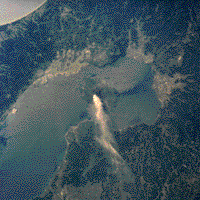
 Part 3 of 8
Part 3 of 8


The Ultimate Field Trip
An Astronaut's View of Earth
by Kathryn D. Sullivan, Ph.D.
NASA Astronaut
 |
|

 Part 3 of 8
Part 3 of 8


 |
|
Like all good explorers and scientists, we try to capture our observations for further analysis and interpretation. Each Shuttle crew is equipped with a diverse array of high quality photographic equipment and a large quantity of film. Personnel in the Space Shuttle Earth Observations Project (SSEOP), which is a cadre of scientists at the Johnson Space Center, prepare a set of sites for each crew to observe and record. The site list is based on requests from numerous scientists around the country and a host of practical factors, such as the spacecraft's groundtrack, our work/sleep cycle, and higher priority activities in the flight plan. A laptop computer aboard the Shuttle displays a constantly updated world map, with the orbit path on it, and alerts us to upcoming observation sites and camera settings. In addition, the SSEOP provides daily updates about new events (volcanic eruptions, for instance, or hurricanes) and the weather conditions over each site. A typical flight will return over 2000 Earth photos, which are added to the more than 80,000 images already in the data base from the Mercury, Gemini, Apollo, Skylab, and Space Shuttle Programs. (Information on how to view and order these photos is provided at the end of this article.)
This photo data base is a valuable scientific and educational resource. The Shuttle's relatively low altitude (compared to that of Landsat and weather satellites) and the high quality of the cameras combine to produce images with quite decent ground resolution (on the order of 50 meters). In addition, crewmembers working together can acquire complementary views simultaneously, such as nadir (straight down) and oblique, or stereo, or natural color and color infrared. The state of the art in image processing makes it feasible to digitize these photos, correct their viewing angles if required, and merge them with other sources of data. These images play a valuable role in scientific studies when combined with satellite data, ground measurements, or the results of numerical modeling.
As I travel around the country attending scientific meetings or speaking to public groups, I find that the chance to see the Earth from orbit is one of the most commonly cited reasons that people wish they could fly in space.
 |
|

 Part 3
Part 3


This local copy was downloaded from http://eol.jsc.nasa.gov/newsletter/uft/uft1.html on 18 Jan 2000.
Responsible NASA official: Dr. Kamlesh Lulla